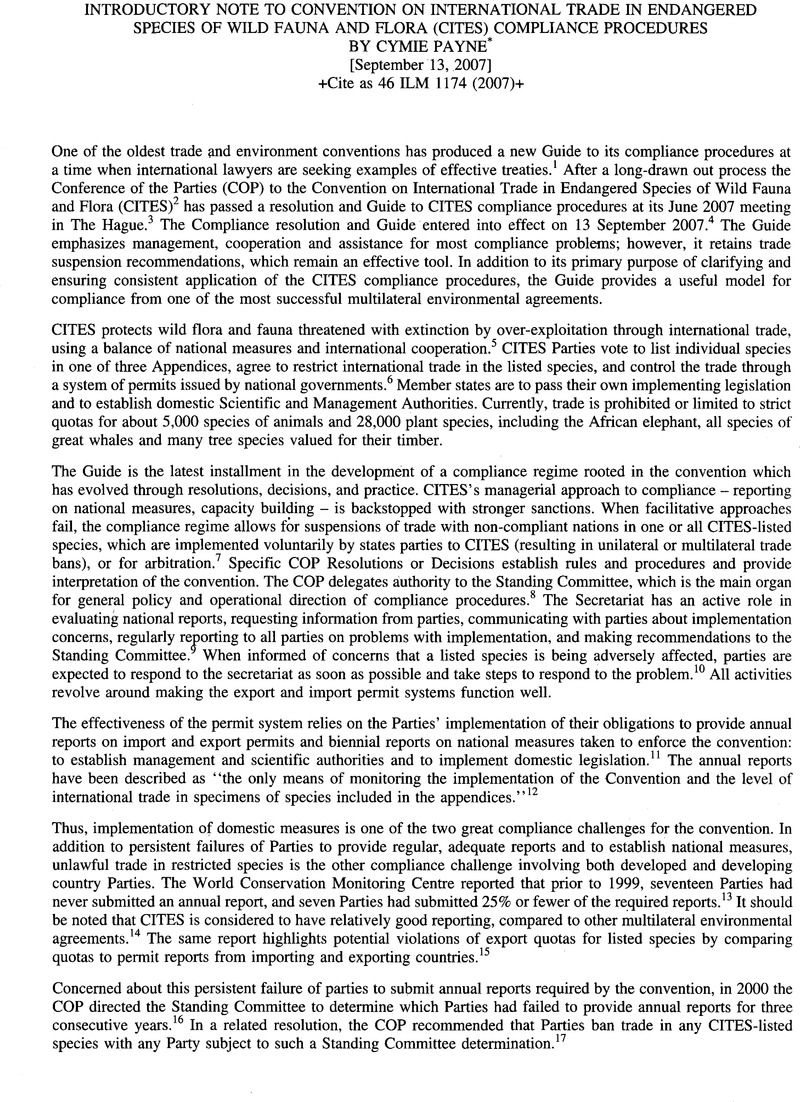Article contents
Convention on International Trade in Endangered Species of Wild Fauna and Flora (Cites) Compliance Procedures
Published online by Cambridge University Press: 27 February 2017
Abstract

- Type
- International Legal Materials
- Information
- Copyright
- Copyright © American Society of International Law 2007
References
Endnotes
1 Enforcement matters are dealt with in a separate context. While the compliance guidelines focus, on Parties’ obligations under the convention, the term “enforcement” has been considered “to refer to matters relating to the illicit trafficking of wild fauna and flora”. Cites CoP13 Doc. 23, para. 15. The COP and Secretariat pursued other initiatives to address a range of enforcement problems and in particular the growing problem of trafficking in illegal wildlife by international drug dealers.
2 Convention on International Trade in Endangered Species of Wild Fauna and Flora (Washington DC, 3 March 1973). Cites currently enjoys the participation of 172 countries; Kyrgyzstan became the most recent party to the Convention in April 2007 (visited 6 Jan. 2008) <http://www.Cites.org/eng/disc/parties/chronolo.shtml>.
3 Resolution 14.3, “Cites compliance procedures” (June 2007).
4 Resolution Conf. 4.6 (Rev. CoP13), “Submission of draft resolutions and other documents for meetings of the Conference of the Parties” . See also New Resolutions adopted at the 14th meeting of the Conference of the Parties (The Hague, June 2007), <http://www.Cites.org/eng/res/14/index.shtml>.
5 Cites, preamble.
6 Cites, Articles II, III, IV, V.
7 Peter Sand provides an excellent explanation of how ‘ ‘multilateral trade bans” or “collective countermeasures” are founded in the convention's Article XIV, Effect on Domestic Legislation and International Conventions. Peter H. Sand, “Sanctions and State Responsibility”, in Ensuring Compliance with Multilateral Environmental Agreements: A Dialogue between Practitioners and Academia, 259, 262 (Ulrich Beyerlin et al., eds. 2006). Other relevant convention text is found in: Article II, Fundamental Principles; Article VIII, Measures to Be Taken by the Parties; Article XI, Conference of the Parties; Article XIII, International Measures; Article XVIII, Resolution of Disputes.
8 Resolution Conf. 11. (Rev. CoP13), “Establishment of Committees” (2004).
9 Cites, Articles XII, XIII.
10 Cites, Article XIII.
11 Cites, Article VIII.
12 Resolution Conf. 9.4, “Annual Reports and Monitoring of Trade” (1994).
13 Jonathan Harwood, World Conservation Monitoring Centre, A Report on Annual Reports Submitted by the Parties to Cites (1999), section 2.1; available in Cites Doc. 11.19, “Report on national reports required under Article VIII, paragraph 7 (a), of the Convention'’ (2000) at <http://www.dtes.-org/eng/cop/1l/doc/index.shtml>.
14 Weiss, Edith Brown, Jacobsen, Harold K., Engaging Countries: Strengthening Compliance with International Environmental Accords 526 (1998).
15 Ibid at section 7.
16 Decision 11.89, “Regarding Annual Reports” (2000). Resolution Conf. 11.17, “Annual reports and monitoring of trade” (2000) (Rev. CoP14). (Defining the failure to submit timely annual reports as a major problem which the Secretariat should refer to the Standing Committee.). Cites Doc. 11.19, “Report on national reports required under Article VIII, Paragraph 7(a), of the convention” highlights concerns with national reporting failures and with the misuse of export quotas.
17 Dec. 11.37, “Regarding Annual Reports” (2000).
18 Notification to the Parties No. 2000/057 (29 September 2000).
19 SC45 Summary Report, p. 13.
20 SC45 Summary Report, pp. 8-9, 12.
21 Cites Secretariat, “Possible Measures for Non-Compliance”, SC46 Doc. 11.3 (March 2002). See also Rosalind Reeve, Policing International Trade in Endangered Species 157 (2002) [hereinafter Reeve 2002].
22 SC46 Summary Report 14 (2002).
23 Decision 12.84, “Compliance with the Convention” (2002).
24 Cites Secretariat, ‘ ‘Draft guidelines on compliance with the Convention,” SC49 Doc. 16 Annex (Apr 2003). See also, Rosalind Reeve, “The Draft Cites Compliance Guidelines: Comments and Revisions'’ on behalf of David Shepherd Wildlife Foundation and International Fund for Animal Welfare (August 2003).
25 Sach, Karsten, “Introduction” in Ensuring Compliance with Multilateral Environmental Agreements: A Dialogue between Practitioners and Academia, ix (Ulrich Beyerlin et al., eds. 2006).
26 SC49 Doc. 16 (2003).
27 SC50, Doc 27 (2004).
28 Resolution Conf. 14.3 (2007).
29 United Nations Environment Programme, Manual on Compliance with and Enforcement of Multilateral Environmental Agreements (2006). UNEP (DEPI)/MEAs/WG.l/3, annex II.
30 SC46 doc 11.3, para. 9(2002).
31 SC46, Summary Report, p. 14 (2002).
32 SC45 Summary Report, 6 (2001) (rejecting Secretariat proposal to establish an Implementation Committee, and noting that the COP had decided not to establish an Enforcement Committee).
33 Veit Koester, “Compliance Committees within MEAs and the Desirability and Feasibility of Establishing Special Compliance Bodies under Cites”, as SC54 Inf. 3 (2004).
34 SC54 Summary Record, item 35 (2006).
35 Conf. 14.3, paras 6, 7.
36 Sand, Peter H., “Japan's ‘Research Whaling’ in the Face of the Endangered Species Convention (Cites),” Review of European Community and International Environmental Law (Reciel) vol. 17:1 (January 2008).
37 Australia to track whaling ships, International Herald Tribune, World News, Asia/Pacific, December 20, 2007 at 3.
38 International: Japan abandons plans to kill humpback whales, The Guardian (London) - Final Edition, December 22, 2007.
39 Three panels of international lawyers, convened by the International Fund for Animal Welfare (IFAW) in Paris, London and Sydney, concurred in Professor Sand's view that Japanese whaling is in violation of Cites. The Sydney Panel also stated that Japan's whaling program is in violation of the UN Convention on the Law of the Sea and the Antarctic Treaty System and suggested that proper fora for legal action might include the International Court of Justice, the International Whaling Commission and the International Tribunal for the Law of the Sea. Australia to track whaling ships, International Herald Tribune, World News, Asia/Pacific, December 20, 2007 at 3.
* This text was reproduced and reformatted from the text appearing at the Cites website: (visited December 3, 2007) < http://www.Cites.org/eng/res/14/14-03.shtml>
1 These currently include: - Resolution Conf. 11.17 (Rev. CoP14) (National reports); - Decision 14.29 (National laws for implementation of the Convention); - Resolution Conf. 12.8 (Rev. CoP13) (Review of Significant trade in specimens of Appendix-II species); - Convention Article XIII and Resolution Conf. 11.3 (Rev. CoP14) (Compliance and enforcement); and - Resolution Conf 11.1 (Rev. CoP14) (Establishment of committees).
- 2
- Cited by


